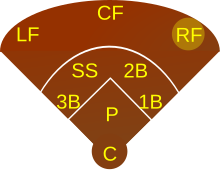Right fielder: Difference between revisions
No edit summary |
|||
| Line 1: | Line 1: | ||
{{Unreferenced|date=August 2007}} |
|||
[[Image:Baseball RF.svg|thumb|right|The position of the right fielder]] |
'''[[Image:Baseball RF.svg|thumb|right|The position of the right fielder]] |
||
A '''right fielder''', abbreviated RF, is the [[outfielder]] in [[baseball]] or [[softball]] who plays defense in '''right field'''. Right field is the area of the outfield to the right of a person standing at [[home plate]] and facing towards the [[pitcher's mound]]. In the numbering system used to record defensive plays, the right fielder is assigned the number 9. |
A '''right fielder''', abbreviated RF, is the [[outfielder]] in [[baseball]] or [[softball]] who plays defense in '''right field'''. Right field is the area of the outfield to the right of a person standing at [[home plate]] and facing towards the [[pitcher's mound]]. In the numbering system used to record defensive plays, the right fielder is assigned the number 9. |
||
| Line 54: | Line 53: | ||
[[fr:Voltigeur de droite]] |
[[fr:Voltigeur de droite]] |
||
'''''''''Bold text'''''<ref>Italic text</ref>''''' |
|||
Revision as of 09:38, 30 January 2014

A right fielder, abbreviated RF, is the outfielder in baseball or softball who plays defense in right field. Right field is the area of the outfield to the right of a person standing at home plate and facing towards the pitcher's mound. In the numbering system used to record defensive plays, the right fielder is assigned the number 9.
Position description
Outfielders must cover large distances, so speed, instincts and quickness to react to the ball are key. They must be able to catch fly balls above their head and on the run, as well as prevent balls hit down the right field foul line from getting past them. Being situated 250–300 feet from home plate, they must be able to throw the ball accurately over a long distance to be effective. Of all outfield positions, the right fielder often has the strongest arm, because they are the farthest from third base.
The right fielder tends to be a stronger offensive player than defensive, as right-handed batters, which are more common than left-handed ones, tend to pull the ball to left field.
As well as the requirements above, the right fielder backs up first base on all throws from the catcher and pitcher, when possible, and all bunted balls, since the catcher or the first baseman must be available for fielding the ball. The right fielder backs up second base on any ball thrown from the left side of the field, i.e. shortstop, third base, or foul line territory. The right fielder backs up first base when the first baseman is in a run down between 3rd base and home.
Right field has developed a reputation in Little League as being a position where less talented players can be "hidden" without damaging a team's defense in any significant way.[citation needed] Unlike the major league level, where hitters have the ability to drive the ball into the outfield in all directions, most little league batters are unable to hit the ball out of the infield with any regularity. Additionally, since most batters are right-handed, the left fielder (and to some extent the center fielder) will have far more opportunities to make a play than the right fielder.
Hall of fame right fielders
- Hank Aaron
- Roberto Clemente
- Sam Crawford
- Kiki Cuyler
- Andre Dawson
- Elmer Flick
- Tony Gwynn
- Harry Heilmann
- Harry Hooper
- Reggie Jackson
- Al Kaline
- Willie Keeler
- King Kelly
- Chuck Klein
- Tommy McCarthy
- Mel Ott
- Sam Rice
- Babe Ruth
- Frank Robinson
- Enos Slaughter
- Sam Thompson
- Paul Waner
- Dave Winfield
- Ross Youngs
See also
''''Bold text[1]
- ^ Italic text

